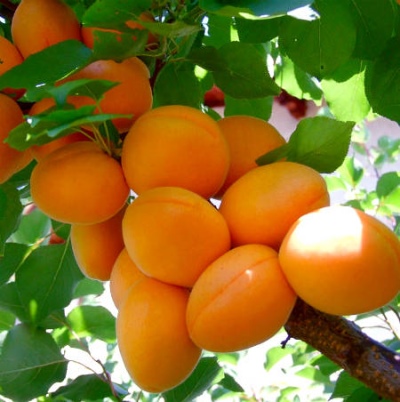
- Authors: J. Lyon, Canada (Ontario)
- Name synonyms: Hargrand, Har Grand
- Tree height, m: up to 5
- Fruit weight, g: 70-80
- Fruit shape: oval, slightly flattened from the side of the peduncle
- Skin : almost smooth, thin but dense
- Fruit color: orange, with a slight mottled blush covering up to 20% of the fruit
- Pulp color : orange, lighter near the stone
- Pulp (consistency): quite firm, buttery, average juiciness
- Fruit taste: harmonious, slightly sour, with a honey flavor
Apricot Hargrand is an attractive variety for gardeners, but unlike most of the grown representatives of these fruit trees, it was not created by domestic breeders. After the official registration, which was carried out two decades after receiving, it began to gain popularity, and is still in demand. This is easily explained by the early maturity, high yield, large fruits with excellent taste and long-term fruiting of the tree.
Breeding history
Most sources say that J. Lyon got a new cultivar by accident, using cultivars Y51092 and NJA-1 as sources. One of them is known in Russia as Gold Rich. After the official registration in Canada, he began to enjoy popularity, which went beyond not only Canada, but also North America. In the temperate climate of the Eastern Hemisphere, it is in demand due to winter hardiness, the ability of the buds not to freeze during short-term late frosts.
Description of the variety
Already in the second year, a young tree begins to bear fruit, experienced gardeners remove part of the ovaries so that it has strength for the growth of branches and vegetative mass. The height of the tree is complemented with a spreading crown with age, so it is important to maintain it in the shape that a young tree has. Apricot lovers appreciate the taste of large fruits. Those who are engaged in breeding for commercial purposes like beautiful and large fruits that tolerate transportation and storage well, retaining their presentation and presentability for quite a long time, the incomparable aroma of apricot, pronounced, without additional impurities.
Fruit characteristics
A large fruit with a small stone can vary in weight from 70 to 80 g, experts recommend that you take care of the tree permanently, otherwise it grows and the fruits become smaller. Apricots are elongated, bright orange in color with red dots that can cover up to a third of their surface. Fruiting can last up to 40 years. There is a nice feature - when ripening, they practically do not crumble to the ground, and yield losses are minimal.
Taste qualities
In fruits with an oily consistency, sourness is weakly felt, but sweetness prevails, and this gives the fruits a special attractiveness in combination with a smooth skin and a unique aroma that persists even during prolonged storage. Other features:
gardeners' reviews say that one fruit with proper care can reach a weight of 150 g;
assessment on a tasting scale 4.4 points;
ripe fruits are covered with a blush, the stone is small, most of the apricot is occupied by juicy pulp;
during thermal processing, the taste and pronounced aroma are preserved;
acids and sugars, vitamins and trace elements prevent the development of vitamin deficiency in the long winter of a temperate climate.
The variety is referred to as universal - it can be eaten with pleasure in its natural form, used to prepare preparations for the winter: vitamin compotes, jam and preserves, baking fillings. The waste in cooking is less than that of other varieties, thanks to the small bone.
Ripening and fruiting
Fruits appear already in the second year after planting, while the Hargrand apricot is able to delight the owners for 4 decades.The expression of taste appears in 2-3 years. Under standard conditions, it ripens by mid-August, but the timing of the appearance of fruits can be adjusted by the region and weather conditions. The amount harvested depends on the age of the tree, the care and availability of a nearby plant with similar flowering times. But the harvest is received annually.

Yield
Reaches high rates, therefore in special sources you can find indications of the need to control the number of ovaries. If this is not done, branches may break from the abundant amount of fruit. Lack of control leads to crushing of the fruit. The yield indicator is assessed as high.
Growing and care
It is recommended to prepare a pit for spring planting in the fall, if it is scheduled for the autumn period, then mineral fertilizers and a little organic matter - wood ash, saltpeter or humus - must be added in advance. Watering, disease prevention, pruning and periodic feeding give optimal results if the place for placement is chosen correctly - the southern direction, without strong air currents, on level ground or on a hill, with constant illumination. The tree gratefully responds to care, pleases the owner with an excellent harvest, especially if feeding is carried out according to the scheme - three times per season: in early spring, during the flowering period and after the fruits are removed.
The near-trunk zone is mulched for the winter, the trunk is covered with whitewash and insulated for the winter in cold regions.



































































